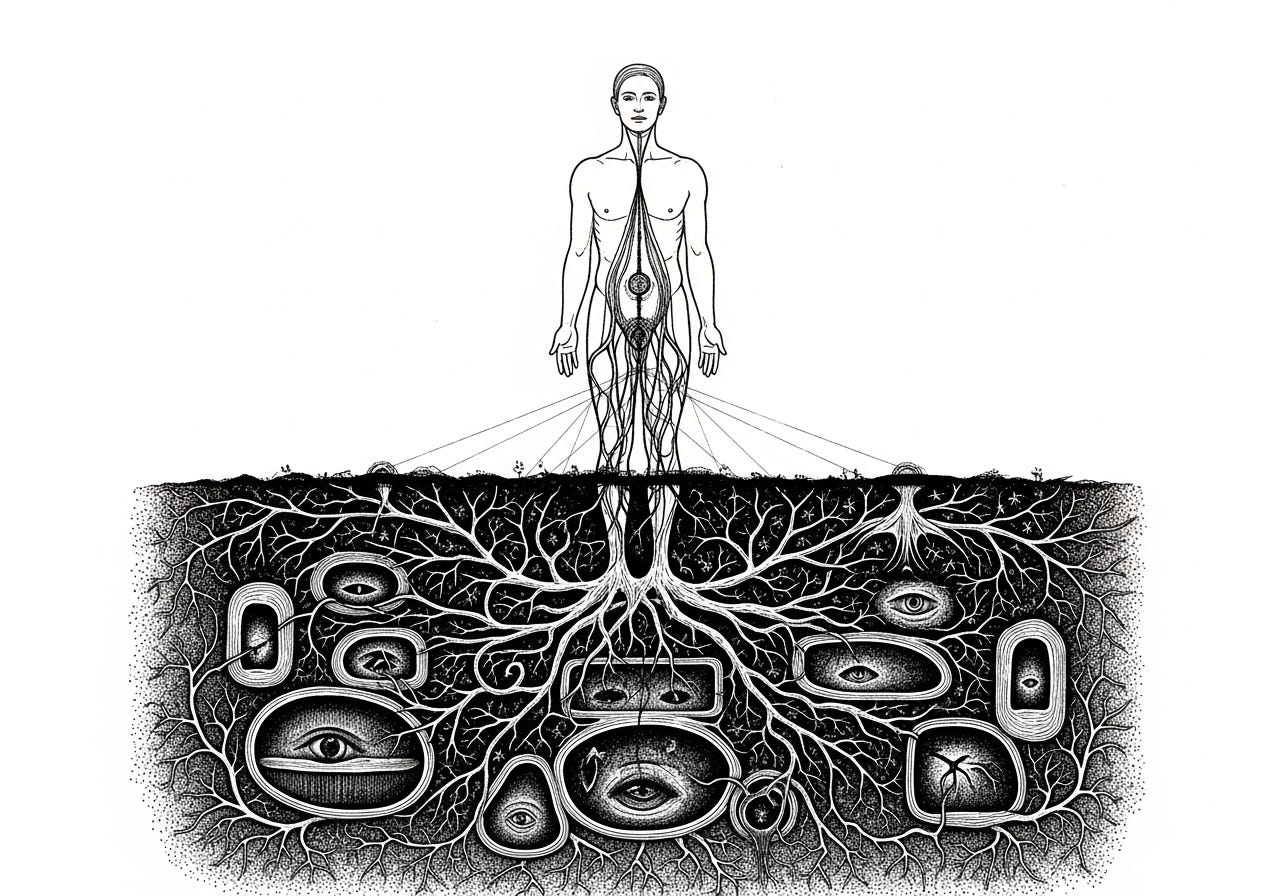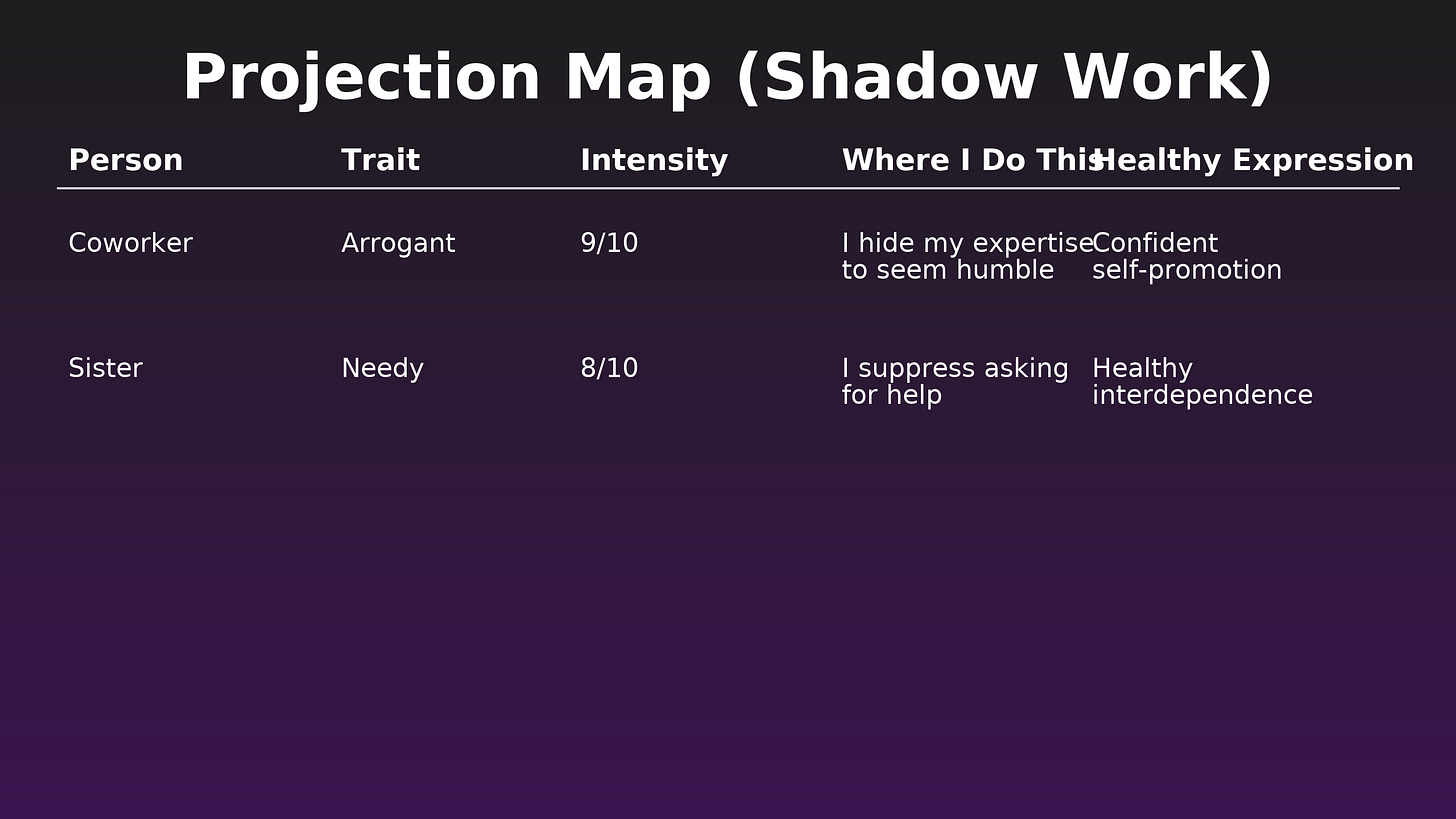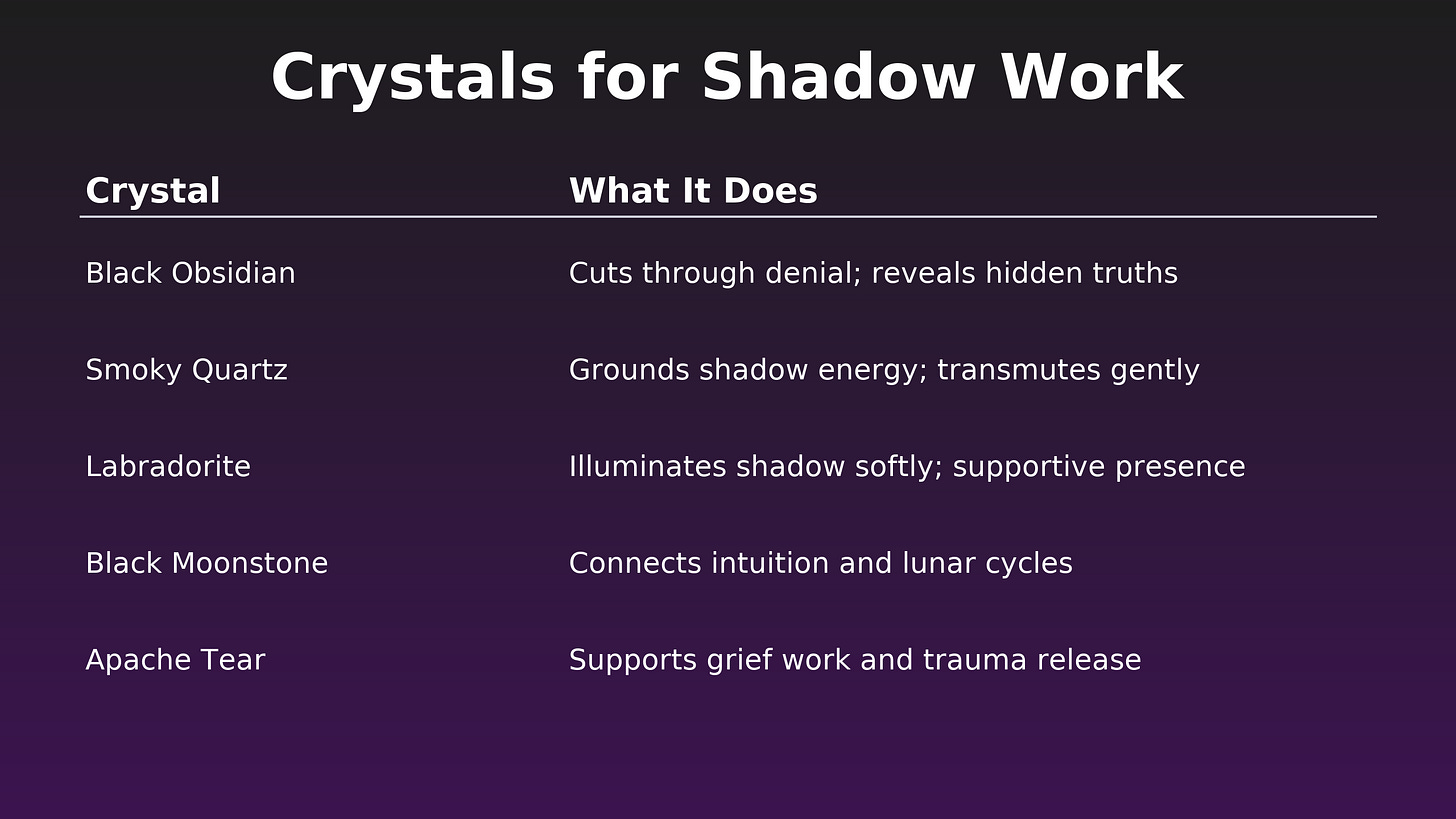The Complete Shadow Work Guide: Transform Your Dark Side Into Your Greatest Power
Why the most successful witches, healers, and spiritual leaders do the work nobody talks about
Here’s something most people won’t tell you straight: you’re probably operating at half capacity. Maybe less.
The other half? It’s buried in what psychologists call your shadow—all the parts of yourself you’ve learned to hide, reject, or pretend don’t exist.
Six years ago, I was deep in the “love and light” phase of my practice. Perfect altar, daily meditations, gratitude journals, the whole setup. On the surface, I looked like I had it together.
But underneath? I was exhausted, resentful, and my spellwork was inconsistent at best.
Some things manifested. Most didn’t. I had no idea why.
Then someone asked me a question I couldn’t dodge:
“What are you actually angry about?”
I laughed it off. I wasn’t angry. I was spiritual.
Except I was lying. To them, and to myself.
That question cracked something open. It led me to shadow work—not the Instagram version with aesthetic journal spreads, but the real thing. The uncomfortable, sometimes messy work of looking at the parts of yourself you’ve been avoiding since childhood.
What I found there wasn’t the monster I expected.
It was power I’d been afraid to claim. Authenticity I’d been too scared to show. And the key to why my magic kept stalling out.
Today I’m walking you through the actual process. The one that works.
What Shadow Work Actually Is (And Why Most People Get It Wrong)
Let’s clear up some misconceptions right away.
Shadow work is not wallowing in negativity. It’s not using your trauma as an excuse to treat people badly. It’s not something you do once in therapy and cross off your list.
And it’s definitely not a replacement for professional mental health support when you need it.
Here’s what it actually is:
Shadow work is the practice of acknowledging, exploring, and integrating the parts of yourself you’ve rejected or repressed.
The emotions you were told were “too much.” The desires you learned to be ashamed of. The traits you buried because someone made you feel like they were dangerous or unacceptable.
Carl Jung, who coined the term “shadow self,” understood something most people spend their lives avoiding:
Whatever you reject in yourself doesn’t disappear. It goes underground. And from down there, it runs your life without your conscious awareness.
Your shadow holds:
Repressed emotions you weren’t allowed to express—anger, jealousy, grief, rage
Rejected traits you’ve been shamed for—ambition, sexuality, neediness, pride
Unmet needs from childhood that still drive your adult behavior
Hidden gifts you buried because they made others uncomfortable
Authentic desires you denied to fit in or avoid judgment
Most people walk around with enormous amounts of energy tied up in keeping their shadow locked down.
That’s energy you could be using for literally anything else—including magic that actually works
.
The Science Behind Shadow Work (Yes, There’s Research)
This isn’t just spiritual theory. Modern psychology backs this up.
Neuroplasticity and emotional regulation: Studies show that when you acknowledge and process repressed emotions, you’re literally changing your brain structure. New neural pathways form that support better emotional regulation and decision-making.
Projection in relationships: Research confirms what Jung observed—we tend to project our denied shadow traits onto other people. That person who irritates you for being “arrogant”? There’s a good chance you’re suppressing your own confidence or expertise. Psychology Today covers this extensively.
Physical health impacts: Emotional repression isn’t just psychological. Studies link it to chronic stress, weakened immune function, and even physical illness. Your body keeps the score.
Manifestation and self-sabotage: When you’re unconsciously fighting parts of yourself, you create internal conflict that directly undermines what you’re trying to manifest. You cast spells while your shadow belief system is working against you. Integration removes that interference.
The 12 Signs Your Shadow Is Running Your Life
Most people don’t realize they’re being controlled by their shadow. Here’s how to tell:
Intense reactions to small things - Someone makes a minor comment and you’re suddenly furious or devastated. The reaction doesn’t match the trigger. If you’re noticing this pattern, pay attention—it’s usually your shadow signaling something unresolved.
Repetitive patterns - Same type of toxic relationship, different person. Same self-sabotage right before success. Same feeling of being misunderstood. When the story keeps repeating, your shadow is writing the script.
Harsh judgment of specific traits - There are certain behaviors in others that make you viscerally uncomfortable or angry. Whatever bothers you most intensely is often what you’ve rejected in yourself.
Spiritual bypassing - You use positivity to avoid dealing with real issues. “Good vibes only” becomes a way to never feel uncomfortable emotions. This is one of the sneakiest forms of shadow avoidance.
Self-sabotage - You undermine your own success at critical moments. You ghost the person you’re falling for. You blow up your career right when things are going well. Your shadow is trying to protect you from something—usually disappointment or exposure.
Imposter syndrome - Despite evidence of your competence, you feel like a fraud. You’re waiting for someone to “find out” you’re not what you seem.
Emotional numbness - You have difficulty accessing your feelings. Everything feels flat or distant.
Perfectionism - You’re terrified of being seen as flawed. Making mistakes feels catastrophic.
People-pleasing - You can’t say no. You can’t disappoint others. Your needs always come last.
Secret shame - There are parts of yourself you hide from everyone, including close friends and partners.
Jealousy and envy - Other people’s success triggers intense negative reactions in you.
Inconsistent magic - Your spells work sometimes but not others, with no clear pattern. Often this is because your conscious intention is fighting your unconscious beliefs.
If you recognized three or more of these, shadow work isn’t optional. It’s essential.
The Shadow Work Journey: 7 Transformative Stages
Shadow work isn’t linear. You don’t complete stage one and move on forever.
It’s more like layers—you spiral through these stages repeatedly, going deeper each time. But understanding the general arc helps you know where you are in the process.
🌘 Stage 1: Recognition (Weeks 1-2)
This is where you start noticing patterns you’ve been blind to.
You catch yourself having a big reaction and instead of immediately justifying it, you pause and ask: Why did that hit me so hard?
What to practice: Shadow journaling
When you have a strong reaction, write: “I react strongly when people are [trait]”
Ask yourself: “What does this say about what I’ve rejected in myself?”
Notice physical sensations—tightness in your chest, heat in your face, tension in your jaw
Real example: Sarah realized she was intensely judgmental toward “attention-seeking” people. When she sat with it honestly, she discovered she’d spent her whole childhood being told that wanting attention was selfish and needy. So she’d learned to hide, stay small, and make herself easy—and then she punished anyone who didn’t.
This stage is about observation, not fixing. You’re building awareness
.
🌑 Stage 2: Acknowledgment (Weeks 3-4)
Recognition is seeing the pattern. Acknowledgment is admitting it’s actually yours.
This is harder than it sounds.
It’s one thing to notice you react strongly to something. It’s another to stand in front of a mirror and say out loud: “I am jealous. I am controlling. I am ashamed of wanting things.”
What to practice: Mirror work
Stand before a mirror and say: “I acknowledge my [anger/shame/jealousy/whatever it is]”
Notice the resistance, the discomfort, the urge to look away
Breathe through it without trying to fix it
Helpful reframe: “I’m allowed to be complicated. Containing contradictions doesn’t make me bad—it makes me human.”
The moment you can name something without immediately defending against it, integration begins.
🌒 Stage 3: Investigation (Weeks 5-8)
Now you start digging into origins. Where did this shadow aspect come from? When did you first learn this part of you wasn’t okay?
This is the stage where people either go too deep too fast (and retraumatize themselves) or avoid it entirely because it’s painful. Both responses make sense. Go slowly here.
What to practice: Timeline archaeology
Map when you first learned to hide this part of yourself
What message did you receive? (”Good girls don’t get angry.” “Boys don’t cry.” “You’re too sensitive.”)
What did you have to sacrifice to be accepted?
How has denying this trait actually cost you?
Important note: If you hit big trauma here—abuse, violence, serious mental health stuff—get professional support. Find a trauma-informed therapist. Shadow work is powerful, but it’s not therapy. Some things need trained support.
Understanding where your shadow formed helps you stop treating it like an enemy.
🌓 Stage 4: Dialogue (Weeks 9-12)
This is where it gets interesting. You start having actual conversations with your shadow aspects, treating them like separate parts of you.
What to practice: Two-chair shadow work
Set up two chairs facing each other. Put a candle between them if that feels right.
Sit in one chair as your conscious self and invite your shadow aspect to sit in the other.
Ask: “What do you need me to know?”
Then switch chairs. Become the shadow. Let it speak.
Real example: Marcus did this with his “selfish” shadow—the part that wanted things, had needs, didn’t want to sacrifice everything for everyone else. What came through surprised him: that part wasn’t selfish. It was exhausted from being invisible. It was trying to protect him by demanding he finally matter to himself.
These conversations can feel awkward at first. You might feel ridiculous.
But if you actually do it, the insights that come through are often startling.
Your shadow isn’t trying to sabotage you—it’s trying to tell you something.
🌔 Stage 5: Compassion (Weeks 13-16)
This is where you develop empathy for your shadow. Not pity—compassion. There’s a difference.
Pity says: “Poor thing, you’re so broken.” Compassion says: “You were doing the best you could with what you had.”
Most shadow work leads you back to a younger version of yourself. The kid who learned to hide anger because anger wasn’t safe. The teenager who suppressed sexuality because desire was shameful. The child who learned their needs were too much.
What to practice: Inner child healing
Visualize the younger version of you who created this shadow
What were they trying to protect?
What did they need that they didn’t receive?
Offer them safety, acceptance, and the words they needed to hear back then
This part can be intense. You might cry more than you expect. That’s normal. You’re grieving what you had to sacrifice to survive.
The shift happens here: Your shadow stops being something you fight and becomes something you understand.
🌕 Stage 6: Integration (Weeks 17-24)
Integration doesn’t mean becoming your shadow or acting out every repressed impulse.
It means having conscious choice.
If you’ve been suppressing anger, integration means learning to set boundaries without apologizing. You get to be assertive. You get to say no.
If you’ve been hiding ambition, integration means pursuing goals without guilt. You get to be competent, knowledgeable, driven—authentically, not arrogantly.
If you’ve been terrified of vulnerability, integration means letting people actually see you.
What to practice: Intentional expression
Choose one integrated shadow trait to practice each week
If you denied anger: practice assertiveness in one situation
If you hid ambition: share a goal publicly without minimizing it
If you suppressed sexuality: explore sensuality in whatever way feels safe
If you rejected vulnerability: share something real with someone you trust
It’s subtle at first. You notice you’re less reactive. You’re not people-pleasing as much. The same painful dynamics stop showing up.
Your magic becomes more consistent because you’re no longer unconsciously undermining yourself.
This is the stage where everything changes.
🌖 Stage 7: Embodiment (Ongoing)
Shadow work never ends. New layers surface. Old patterns reactivate under stress. Life brings experiences that touch parts of you that need attention.
What to practice: Regular shadow maintenance
Monthly check-ins with yourself
Immediate processing when something triggers you strongly
Ongoing curiosity about your reactions instead of judgment
Celebration when you notice integration working
The difference after you’ve done the initial work: it’s not as terrifying anymore. You know how to do this. You trust the process.
Shadow Work Techniques That Actually Work
Here are practical methods. Use what resonates. Skip what doesn’t
🔥 The Burning Bowl Ritual
This one’s specifically for releasing shame and reclaiming rejected parts.
You need:
Fireproof bowl
Black candle
Paper and pen
Matches or lighter
Process:
Light the black candle
Write on paper: “I am ashamed that I am [ambitious/angry/sexual/needy/proud/whatever]”
Read it out loud and let yourself feel the shame fully—the tightness in your chest, the heat in your face
Burn the paper while saying: “I release this shame. I reclaim [trait]. It is mine. It’s neutral.”
Sit with the ashes. Let them represent transformation, not destruction.
Real result: After Gabriela did this with her shame around ambition, she finally launched the business she’d been hiding for three years. Six months later, she’d made six figures. Not because the ritual was magic—though maybe it was—but because she stopped sabotaging herself.
🌙 Dark Moon Shadow Meditation
Best done during the new moon, but honestly, any time works if you’re called to it.
The practice:
Turn off all lights. Sit in complete darkness.
Light a single black candle.
Gaze at the flame and ask: “What shadow is asking for my attention right now?”
Close your eyes. Don’t force anything. Just witness what comes up—images, memories, sensations in your body.
When you’re done (you’ll know), write down everything that came through. Don’t edit or interpret yet. Just record.
Advanced version: Add scrying with a black mirror or bowl of dark water.
📝 The Projection Map Exercise
This one’s uncomfortably accurate for identifying shadow through judgment.
Instructions:
List 5 people who trigger strong negative reactions in you
Write the specific trait that bothers you about each person
Rate the intensity (1-10)
Ask: “Where do I do this, even subtly?”
Ask: “Where did I learn this trait was unacceptable?”
Ask: “How might this trait actually serve me if expressed in a healthy way?”
Example:
Research on projection confirms what Jung knew: the traits we judge most harshly in others are often the ones we’ve rejected in ourselves.
🎭 Shadow Archetypal Work
Sometimes it helps to work with shadow through archetypal energy. Jung identified universal patterns that show up across cultures.
Common shadow archetypes:
The Victim - Learned helplessness, blame, powerlessness
Shadow gift: Empathy, awareness of injustice, compassion
Integration: Reclaim power while keeping your heart open
The Tyrant - Control, domination, ruthlessness
Shadow gift: Leadership, decisiveness, strong boundaries
Integration: Lead without crushing others
The Seductress/Seducer - Manipulation through sexuality or charm
Shadow gift: Personal magnetism, authentic attraction, creative power
Integration: Own your appeal without weaponizing it
The Saboteur - Self-destruction, undermining success
Shadow gift: Protection from disappointment, pattern recognition
Integration: Build success carefully instead of preemptively destroying it
Practice idea: Create a small altar honoring one shadow archetype each month. Put objects on it that represent that energy. Sit with it. Ask what it needs. Learn from it.
💎 Crystal Allies for Shadow Work
You don’t need crystals for shadow work. But if you work with stones, certain ones support this process.
Simple shadow grid:
Place black obsidian in the center (truth)
Place smoky quartz in the four corners (grounding)
Sit in the center and meditate
Only do this if you’re ready for what might surface.
Shadow Work Journaling: The Questions That Change Everything
Shadow work lives in writing. Not polished writing—raw writing. The kind where you don’t edit or perform.
Daily check-in questions:
What triggered me today?
What part of myself did I hide today?
What judgment did I make about someone else?
What pattern am I noticing?
What am I afraid to admit about myself?
Deep dive prompts:
On Anger:
What am I not letting myself be angry about?
How was anger modeled in my childhood?
What would I say if I let my rage speak without censoring?
Who would I disappoint if I got angry?
On Shame:
What do I believe makes me unlovable?
What do I hide because I fear rejection?
What part of me have I decided is “too much”?
If shame didn’t exist, how would I live differently?
On Power:
Where do I play small to make others comfortable?
What greatness am I afraid to claim?
Who taught me my power was dangerous?
What would I create if I embraced my full power?
On Desire:
What do I secretly want but won’t admit?
What desires have I labeled “selfish” or “wrong”?
What would I pursue if I wasn’t afraid of judgment?
How do I punish myself for wanting?
These aren’t one-time questions. You’ll come back to them repeatedly. Your answers will change. That’s the point.
Why Shadow Work Makes Your Magic Actually Work
Here’s what most witchcraft books don’t tell you:
If you haven’t done shadow work, your magic will be inconsistent. Sometimes it works. Sometimes it doesn’t. You’ll have no idea why.
That’s because magic works through alignment.
When your conscious intention and unconscious beliefs are fighting each other, you create interference. Static. You cancel yourself out.
Internal conflict = energetic static
Conscious mind: “I want abundance”
Shadow belief: “I don’t deserve wealth”
Result: Your spell fizzles because you’re working against yourself
Projection = misdirected energy
Conscious goal: “Attract a loving partner”
Shadow reality: You reject the traits you need in a partner
Result: You repel or sabotage good matches
Spiritual bypassing = surface-level magic
Conscious practice: “Love and light only”
Shadow reality: Unexpressed rage and unprocessed grief
Result: Weak, inconsistent results because you won’t go deep
Integration changes everything.
Your magic becomes coherent. No more internal conflict. No more unconscious sabotage.
Shadow-integrated magic:
Anger magic becomes boundary work, cord-cutting, banishing
Grief magic becomes ancestor work, water scrying, honoring loss
Desire magic becomes manifestation without guilt, pleasure rituals
Power magic becomes leadership work, confidence spells, claiming authority
The dark goddess connection:
Shadow work naturally aligns you with goddesses who aren’t all sweetness:
Kali - Destruction and transformation
Hecate - Crossroads and shadow wisdom
Lilith - Sovereignty and refusing to be diminished
Morrigan - War, victory, and necessary endings
Persephone - Descent, return, and knowing both worlds
These aren’t “evil” deities. They’re whole. They hold both creation and destruction.
They know real power comes from integration, not denial.
Common Shadow Work Mistakes (And How to Avoid Them)
Mistake #1: Confusing shadow work with wallowing
There’s a difference between processing pain and marinating in it.
Shadow work acknowledges what’s there, feels it, and moves toward integration. It’s active, not passive. If you’re stuck in victim mentality, using trauma as identity, not moving forward—that’s not shadow work. That’s avoidance in disguise.
Mistake #2: Using shadow work as an excuse
“It’s just my shadow” is not a free pass for treating people badly.
Integration means conscious choice. If you’re still blaming your shadow for your behavior, you’re not integrated—you’re acting out.
Mistake #3: Doing deep trauma work alone
If what comes up is serious trauma—abuse, violence, addiction, complex PTSD—you need professional support.
Shadow work is not therapy. Find someone trained in trauma-informed modalities: EMDR, somatic experiencing, Internal Family Systems. Someone who can help you process without retraumatizing yourself.
There’s no shame in needing help. Only harm in pretending you don’t.
Mistake #4: Rushing it
You can’t speedrun shadow work.
The psyche doesn’t work on a 21-day challenge timeline. Integration takes time, repetition, patience. If you’re trying to “fix” your shadow quickly so you can move on, you’re missing the point.
Trust the process. Trust the pace.
Mistake #5: Intellectualizing instead of feeling
This one’s sneaky. You read all the books, understand all the concepts, can explain projection and integration in therapy-speak—but you’re not actually feeling anything.
Integration doesn’t happen in your mind. It happens in your body, in the felt experience. You have to actually let yourself feel the anger, grief, shame—not just think about it.
If you catch yourself analyzing instead of experiencing, drop into your body. Breathe into your belly. Feel where the emotion lives.
Your 90-Day Shadow Work Transformation Program
Here’s a practical roadmap. But don’t treat it rigidly. Skip what doesn’t resonate. Spend longer on what needs more time. This is a map, not a mandate.
Month 1: Recognition & Acknowledgment
Week 1: Trigger tracking
Journal every strong emotional reaction
Note what happened, what you felt, how intense it was
Look for patterns
Week 2: Shadow inventory
List traits you judge harshly in others
Identify emotions you never let yourself feel
Name desires you’ve labeled “wrong”
Week 3: Mirror work
Daily practice: stand before a mirror and say “I acknowledge my [shadow trait]”
Notice physical sensations and resistance
Practice self-compassion
Week 4: Origin investigation
Pick one shadow aspect and trace it back
When did you first learn it wasn’t okay?
What did you sacrifice to be accepted?
How has hiding this cost you?
Month 2: Investigation & Dialogue
Weeks 5-6: Shadow conversations
Weekly two-chair dialogues with shadow aspects
Let the shadow speak without judging or fixing
Write down insights
Week 7: Dark moon ritual
Perform deep shadow meditation during new moon
Scrying for shadow messages
Honor what arises without trying to fix it
Week 8: Integration planning
For each shadow aspect, identify healthy expression
Create action steps
Set boundaries with people who trigger shadow reactions
Month 3: Compassion & Integration
Weeks 9-10: Inner child healing
Daily visualization with younger self
Reparenting practices for wounded parts
Offer compassion to shadow aspects
Week 11: Intentional expression
Begin expressing integrated shadow traits
Practice new behaviors in safe contexts
Celebrate small wins
Week 12: Embodiment ritual
Create a ceremony honoring your journey
Burn what you’re releasing
Plant seeds (literal or symbolic) for integrated self
Commit to ongoing maintenance
Shadow Work and Relationships: The Ultimate Truth Test
Want to know if your shadow work is actually working? Look at your relationships.
Before shadow integration:
Repetitive toxic patterns
Intense reactions to partner’s behavior
Codependency or avoidance
Constant projection
Feeling triggered all the time
After shadow integration:
Healthier relationship choices
Ability to self-regulate
Clear boundaries without guilt
Taking responsibility for your reactions
Attracting more compatible people
The principle: Once you integrate a shadow aspect, you stop attracting people who mirror it back to you.
Your partner becomes a companion, not a teacher forcing you to look at what you won’t see.
If you’re noticing this shift happening, your integration work is landing.
When Shadow Work Gets Dark: Safety Protocols
Shadow work can bring up intense material. Here’s when to stop solo work and get support:
Red flags:
Suicidal thoughts or self-harm impulses
Flashbacks or dissociation
Inability to function in daily life
Substance abuse escalation
Intense rage with violent thoughts
Get help:
Find a trauma-informed therapist (EMDR, somatic experiencing, IFS)
Call crisis lines if needed (988 for suicide prevention)
Reach out to trusted people
Join support groups for specific issues
Shadow work is meant to integrate and heal, not destroy you. If it’s overwhelming, that’s information. It means you need more support than you can give yourself. That’s okay.
The Shadow Work Paradox: Light Requires Darkness
Here’s the truth at the center of all this:
You cannot embody your highest light without embracing your deepest darkness.
Compassion requires knowing pain. Courage requires facing fear. Authenticity requires accepting all your parts—even the ones you don’t like. Power requires integrating shadow, not bypassing it.
The witches, healers, and spiritual leaders you admire? They’ve done this work.
That’s why their presence feels solid and real instead of artificially “spiritual.” That’s why their magic lands. That’s why they can hold space for other people’s darkness without flinching.
They know their own.
Your Shadow Work Begins Now
You have two choices:
Choice 1: Close this and go back to spiritual bypassing. Keep wondering why your magic stays superficial. Keep attracting the same patterns. Keep performing a version of yourself that looks spiritual but feels empty.
Choice 2: Begin. Tonight.
Your first step:
Light a black candle
Write in your journal: “What part of myself have I been most afraid to acknowledge?”
Sit with whatever comes up
Say out loud or silently: “All of me is welcome here”
Your shadow isn’t your enemy.
It’s the key to your wholeness, your power, your authentic magic.
The dark moon is always calling. The only question is whether you’ll answer.
Next week: I’m sharing advanced deity work practices that transform shadow integration into spiritual sovereignty. Plus the dark goddess invocation that changed my entire practice.
In shadow and in light,
Nick
P.S. Shadow work isn’t easy. The discomfort you feel reading this? That’s your shadow asking for attention. Don’t turn away. This is where real power begins.
Share your journey: What shadow aspect are you ready to face? Your courage inspires this whole community.









Excellent piece. Thanks!!
I love this, thank you. Your posts are so well written. Thankful I stumbled upon your account.